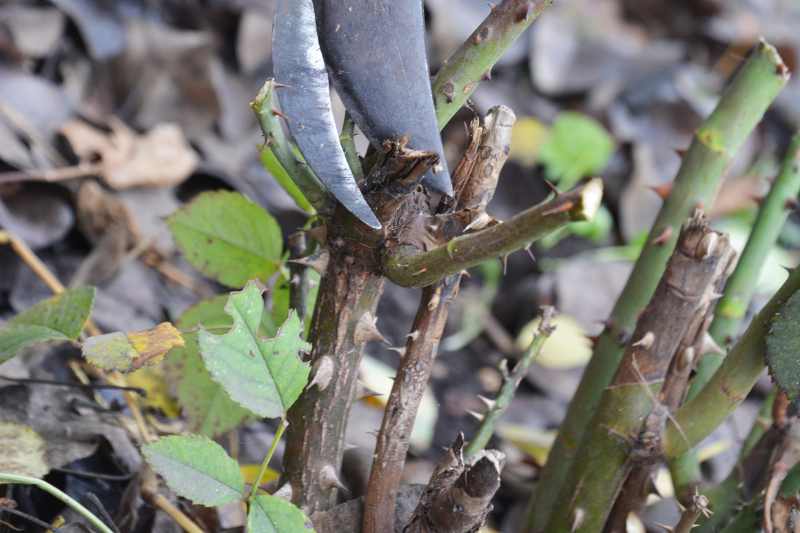Old climbing roses no longer have the vitality of their youth, and often suffer from poor flowering, thinning and poor foliage. Don’t panic, it is possible to get them growing again and to recover them. This also applies to neglected roses that have formed a lot of old wood and can, with a little appropriate care, regain vigour.
So when and how should you prune an old climbing rose to rejuvenate it? Here are some tips and the technique to make your ageing climbing roses flower again and to save them!

How long does a rose bush live?
Roses have a fairly long lifespan, and for a climbing rose you will often find specimens around twenty years old, sometimes 30 years. But they can be neglected and, left without care or pruning, they eventually decline.
Although they can live a long time, the vigour of the shoots gradually decreases over the years, leading to reduced flowering. To promote a stronger floral development on an old specimen, we will carry out a specific, severe pruning known as rejuvenation.
When and how to prune an old climbing rose to rejuvenate it?
Best time to prune
Exceptional hard pruning, as is done on a very old rose that will be cut back more or less to the stump, is carried out in mid-winter, from January until the end of February in cold areas: at this time the sap circulates little or very slowly, and severe pruning causes no problem.
Technically speaking, for a non-perpetual climbing rose (which flowers only once, around June), flower bud induction takes place on last year’s wood, that is on one-year-old shoots or older; for a perpetual climbing rose (which flowers continuously or several times), it takes place on this year’s wood and last year’s wood.
This means you must know whether the rose is perpetual or not before pruning. If you prune a non-perpetual rose in winter, bear in mind flowering will be largely sacrificed the first year, but flowering will be reduced the first year anyway while the rose produces brand new shoots.
Necessary equipment
- sturdy gardening gloves or rose-specific gloves
- pruning shears well sharpened and disinfected with methylated spirits
- a branch cutter (loppers) or a pruning saw
- flexible ties
- a wheelbarrow to remove pruning waste
The technique
- Examine your rose bush: look for dead and bare branches – they are dry, greyish and brittle. They will no longer carry flowers. To be sure, scratch the bark a little higher up: healthy shoots remain green under the nail, dead ones are black or brown: cut them back to their base with the pruning shear or loppers
- Also remove the old, thick shoots, brown and dry, cutting flush with the loppers or pruning saw, so as to keep only the younger, still green branches
- Spot any suckers which often appear on declining plants: these suckers shoot from the base and weaken the rose, they are located below the graft union and are recognisable by their paler green stem: cut them off flush, removing the underground part that links them to the rose if necessary, to redirect sap towards the main structural branches
- Keep 3 or 4 of the most vigorous main branches (those located above the graft union)
- Do not touch these main branches! You will need to prune all lateral branches. Cut them back to 2 or 3 eyes or to 15 cm from their junction with the main branch: cut 0.5–1 cm from the eye, at a slant so rainwater does not run onto the future bud. This would cause tissue splitting with successive freezes and thaws.
- Bend the main branches as flat as possible using the ties: training them this way evens out the sap flow and encourages the production of new floriferous shoots along the length of the branch, much like pegging
- At this stage you will have removed many shoots, and the rose will be ready to receive sun and light to regrow well

- Finally, look after the base of the rose: by lightly forking the soil, to remove any adventive weeds, incorporating some potassium-rich rose fertiliser or a slow-release type such as horn meal, or, even better, compost or well-rotted manure
- Spread a thin layer of mulch 2–3 cm thick: for example a mix of dried grass clippings and wood chip, or fallen leaves, which will help retain a beneficial coolness for the rose. For laying mulch, wait until the soil has warmed up a little in spring.
- In May–June, when the rose has normally started flowering, remove the flowers as they fade, with the pruning shear, to stimulate further flowering, as climbing roses are often perpetual.

































Comments